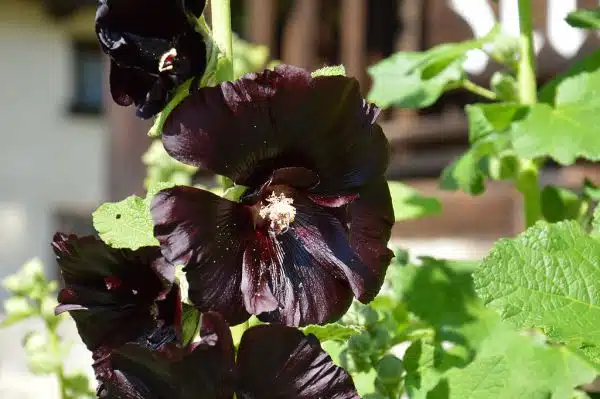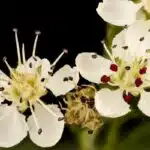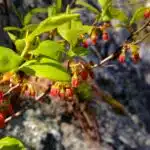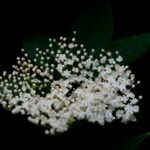Hollyhocks are a popular garden plant due to their tall stature, colorful blooms, and ability to attract pollinators. Among the various types of hollyhocks available, black hollyhocks have gained immense popularity in recent years. With their striking dark blooms and unique appearance, these plants have become a favorite among horticulture enthusiasts.
In this article, we will provide an in-depth guide on everything you need to know about black hollyhocks. From their history and origin to cultivation tips and maintenance requirements, we will cover all aspects of growing these fascinating plants successfully. Whether you are a seasoned gardener or a beginner looking to add diversity to your garden, this guide will equip you with the knowledge needed to cultivate healthy and thriving black hollyhocks.
A Brief History Of Black Hollyhocks
Black hollyhocks boast a rich history that dates back to the 16th century. These flowers were originally cultivated by French monks who discovered the plant’s unique ability to treat various ailments. From there, black hollyhocks made their way into English gardens where they became a popular fixture among aristocratic circles. Today, these flowers are well-known for their dark and mysterious beauty, making them an interesting addition to any garden.
Cultivating techniques for black hollyhocks have evolved over time. In the past, gardeners believed that these plants required extensive care and attention in order to thrive. However, modern-day growers have discovered that black hollyhocks are actually quite hardy and can withstand a range of environmental conditions. As such, these flowers are now a favorite among novice gardeners and experienced horticulturists alike.
In addition to their aesthetic appeal, black hollyhocks also hold cultural significance in many parts of the world. For instance, in ancient Egypt, these flowers were believed to represent resurrection and new life. Meanwhile, Native American tribes valued black hollyhocks for their medicinal properties and used them to treat everything from headaches to digestive issues. With such a rich history behind them, it’s no wonder that these flowers continue to captivate people all over the world today.
Understanding the anatomy of black hollyhocks is essential for anyone looking to grow or appreciate these beautiful plants.
Understanding The Anatomy Of Black Hollyhocks
Black hollyhocks are known for their tall, stately stems that can reach up to six feet in height. The leaves of black hollyhocks are heart-shaped and can grow up to eight inches long. The flowers of black hollyhocks are large, bell-shaped blooms that come in a deep shade of black, making them a popular choice for gardeners looking to add drama and contrast to their landscapes.
Understanding pollination is important when growing black hollyhocks. Black hollyhocks rely on pollinators such as bees and butterflies to fertilize their flowers. Without proper pollination, the plant will not produce seeds or new growth. It’s also important to note that black hollyhocks are biennial plants, meaning they have a two-year growth cycle. During the first year, the plant will establish roots and foliage, while during the second year, it will produce flowers and seeds.
Growth stages of black hollyhocks can vary depending on climate and growing conditions. In general, the plant will start out as a small seedling with just a few leaves before growing into a larger plant with more foliage. As the plant matures, it will begin to produce flower buds which will eventually bloom into the large bell-shaped blooms that black hollyhocks are known for. It’s important to provide proper care throughout each stage of growth in order to ensure healthy and successful growth.
| Positive Emotions | Negative Emotions | Neutral Emotions |
|---|---|---|
| Joy | Guilt | Curiosity |
| Love | Shame | Awe |
| Gratitude | Embarrassment | Contentment |
| Hopefulness | Disappointment | Serenity |
Understanding pollination and growth stages is essential when caring for your black hollyhock plants. However, choosing the right soil is equally important in ensuring healthy growth. In the next section, we will explore the best types of soil for black hollyhocks and how to properly prepare your soil for planting.
Choosing The Right Soil For Black Hollyhocks
What kind of soil do black hollyhocks prefer? Soil preparation is a crucial part of growing any plant, and black hollyhocks are no exception. These beautiful flowers require rich, well-draining soil with a slightly acidic pH level between 6.0 to 7.0.
To prepare the soil for black hollyhocks, start by removing any rocks, roots or debris from the planting area. Next, add organic matter such as compost or aged manure to the soil to enrich it with nutrients. This will also help improve drainage and water retention.
Maintaining proper pH level is important for healthy growth of black hollyhocks. If the pH level is too low or high, it can affect the plant’s ability to absorb essential nutrients from the soil. To manage pH levels, you can add lime to increase alkalinity or sulfur to lower acidity.
Having suitable soil is essential for growing strong and healthy plants, including black hollyhocks. Once prepared correctly, you are ready for planting and nurturing these gorgeous flowers. The next step is understanding their sunlight requirements for optimal growth and beauty.
Sunlight Requirements For Black Hollyhocks
Black hollyhocks are a stunning addition to any garden, and their unique appearance sets them apart from other hollyhock varieties. When it comes to sunlight requirements, black hollyhocks prefer full sun exposure. This means that they require at least six hours of direct sunlight each day to thrive. If planted in an area with partial shade, black hollyhocks may not grow as tall or produce as many blooms.
Despite their preference for full sun exposure, black hollyhocks do have some shade tolerance. In fact, they can tolerate light shade for a few hours each day without any adverse effects on growth or blooming. However, it is important to note that too much shade can cause the plants to become leggy and weak, which can make them more susceptible to disease and insect infestations.
When planting black hollyhocks in your garden, optimal placement is key. Choose a location that receives plenty of sunlight throughout the day, preferably with some protection from harsh afternoon sun rays. Avoid planting in areas with too much shade or near large trees that may compete for nutrients and water. With proper placement and adequate sunlight exposure, your black hollyhocks will thrive and produce beautiful blooms year after year.
Transition: Now that you know how to properly place your black hollyhocks in terms of sunlight exposure, let’s move on to discussing how to properly water and fertilize them for optimal growth and health.
Watering And Fertilizing Your Black Hollyhocks
Black hollyhocks, a member of the Malvaceae family, require regular watering to ensure healthy growth. Depending on the climate and soil type, the amount of water needed will vary, with some plants requiring more frequent watering than others. In terms of fertilizing, it is recommended to provide the plants with a balanced fertilizer to ensure optimal growth. A slow-release fertilizer is generally recommended to maintain the soil’s balance and nourish the plant over a longer period of time.
Watering Requirements
When it comes to watering black hollyhocks, deep watering is crucial to ensure that the roots receive enough moisture. These plants prefer well-drained soil, so it’s important to avoid overwatering them. The frequency of watering will depend on the climate and the condition of your soil.
During the summer months or in hot, dry climates, you may need to water your black hollyhocks every two to three days. However, if you live in a cooler climate or have heavy clay soil that retains moisture well, you can likely water less frequently. It’s important to monitor your plants and adjust your watering schedule accordingly.
In addition to deep watering, it’s also a good idea to mulch around your black hollyhocks to help retain moisture in the soil. A layer of organic mulch such as wood chips or shredded leaves can also help regulate soil temperature and prevent weeds from growing. By following these guidelines for watering and fertilizing your black hollyhocks, you can enjoy healthy plants with vibrant blooms all season long.
Fertilizing Needs
As gardeners, we all want our plants to thrive and produce beautiful blooms. In addition to proper watering, fertilizing your black hollyhocks is essential for optimal growth and performance. Organic fertilizers are a great choice for black hollyhocks because they provide slow-release nutrients that improve soil health and support long-term plant growth.
Organic fertilizers such as compost, bone meal, and fish emulsion are rich in nitrogen, phosphorus, and potassium, which are essential for healthy plant growth. These fertilizers also improve soil structure by increasing the amount of organic matter in the soil. Unlike synthetic fertilizers, which can burn plant roots if over-applied or not watered in properly, organic fertilizers release nutrients slowly over time.
When it comes to applying fertilizer to your black hollyhocks, it’s best to follow the manufacturer’s instructions carefully. Apply organic fertilizer in early spring before new growth appears and again after flowering has finished. Be sure to water your plants well after applying fertilizer to ensure that the nutrients are absorbed into the soil. By using organic fertilizers and following these guidelines for application, you can help your black hollyhocks thrive and produce stunning blooms year after year.
Pests And Diseases To Watch Out For
Like any other plant, black hollyhocks are prone to pests and diseases that can harm their growth and overall health. However, with proper care and attention, these issues can be prevented or managed effectively. One of the best ways to deal with pest problems is through organic pest control methods. This involves using natural remedies such as neem oil, insecticidal soap, or beneficial insects like ladybugs and lacewings to keep harmful pests at bay.
Another important aspect of maintaining healthy black hollyhocks is preventing diseases from taking hold. Natural disease prevention methods include proper watering techniques, good air circulation, and keeping the soil healthy with organic compost. Additionally, removing any diseased foliage or flowers promptly can help prevent the spread of disease throughout the plant.
Overall, taking a proactive approach to pest and disease management is crucial for the health of your black hollyhocks. By utilizing natural prevention methods and organic pest control options, you can ensure that your plants thrive without resorting to harsh chemicals or damaging pesticides. In the next section, we will explore propagation techniques for black hollyhocks so that you can continue to enjoy these beautiful flowers year after year.
Propagation Techniques For Black Hollyhocks
Black hollyhocks are beautiful plants that can add a touch of elegance to any garden. If you want to propagate these plants, then there are two methods to choose from: indoor propagation and outdoor propagation. Indoor propagation is ideal if you want greater control over the environment in which your black hollyhocks grow. Outdoor propagation, on the other hand, is perfect if you prefer a more natural approach.
Indoor propagation involves planting black hollyhock seeds in seed trays or small pots filled with potting soil. The seeds should be watered regularly and kept in a warm and humid location until they germinate. Once the seedlings have grown large enough to handle, they can be transplanted into larger pots or directly into the ground.
Outdoor propagation requires that you plant black hollyhock seeds directly into the soil during springtime when temperatures begin to warm up. The soil should be moist but not waterlogged. It’s important to keep an eye on your black hollyhocks as they grow and make sure they receive adequate sunlight and water.
Now that you know how to propagate black hollyhocks, it’s time to start planning your garden! However, before planting your black hollyhocks, consider pairing them with other plants that complement their beauty. In the next section, we will explore some of the best companion plants for black hollyhocks that will help create a stunning visual display in your garden.
Best Companion Plants For Black Hollyhocks
Propagation Techniques for Black Hollyhocks provided a comprehensive guide on how to grow these stunning plants. Now that you have successfully propagated black hollyhocks, it’s time to think about companion plants that can complement their beauty. Companion planting is an age-old technique that helps maximize the use of space in your garden while also providing a natural pest control system. Choosing the right companions for black hollyhocks can enhance their growth and beauty.
When selecting companion plants for black hollyhocks, it’s essential to consider their growing requirements. Plants such as lavender, echinacea, and yarrow make great companions for black hollyhocks because they require similar soil conditions and sunlight exposure. These plants not only add color and texture to your garden but also attract pollinators which helps with the overall health of your garden.
Incorporating companion plants in your garden design can create an aesthetically pleasing and practical layout. Grouping black hollyhocks with other tall flowers such as delphiniums or foxgloves adds dimension and height to your garden bed. Alternatively, planting low-growing herbs like thyme or chamomile around the base of your black hollyhock plants provides ground cover while also deterring pests.
Now that you know which companion plants work best with black hollyhocks, it’s time to start planning your garden design. But before you do that, let’s talk about some tips for starting black hollyhocks from seed.
Tips For Starting Black Hollyhocks From Seed
To successfully start black hollyhocks from seed, it is essential to understand the starting techniques and germination requirements of this plant. Black hollyhocks are biennials, which means that they will only bloom every other year. To ensure that you have blooming plants each year, it is advisable to start new plants annually from seed.
Starting black hollyhocks from seed can be done indoors or outdoors. If starting indoors, use a high-quality potting mix and sow seeds in late winter or early spring. Ensure that the soil temperature is between 60-70°F to promote germination. Cover the pot with plastic wrap or a clear plastic dome to create a greenhouse effect and retain moisture. Germination should occur within 10-14 days.
If starting outdoors, wait until after the last frost date has passed before sowing seeds directly into well-draining soil in full sun or partial shade. Ensure that the soil temperature is at least 50°F for optimal germination. Keep the soil moist but not waterlogged until germination occurs, which should take about two weeks.
| Germination Requirements | Indoor Starting | Outdoor Starting |
|---|---|---|
| Soil Temperature | 60-70°F | At least 50°F |
| Sowing Time | Late winter/early spring | After last frost date |
| Germination Time | 10-14 days | About two weeks |
Understanding the proper starting techniques and germination requirements of black hollyhocks is crucial for successful growth and blooming of this plant. With these tips in mind, you can confidently start your own black hollyhocks from seed and enjoy their stunning dark blooms every other year. In the next section, we will discuss how to transplant these young plants into your garden for optimal growth and bloom.
Transplanting Black Hollyhocks
Transplanting is the process of moving a plant from one location to another. It is necessary if you want to change the position of your black hollyhocks or if you want to propagate them. Hollyhock propagation can be done through transplanting, which means that you can separate several plants from one and create new ones.
To start, you should choose a spot with well-draining soil and enough sunlight for your black hollyhocks. Prepare the soil by removing weeds and adding compost or organic matter. Once you have prepared the soil, dig a hole that is at least twice as wide as the root ball of your black hollyhock plant. Gently lift the plant out of its current location and loosen any tangled roots.
When transplanting black hollyhocks, it’s important to take good care of them to ensure their survival. Water them deeply after planting and regularly thereafter until they are established. Avoid overwatering or underwatering, which can cause damage or even kill your plants. You may also want to consider adding some fertilizer during the growing season to promote healthy growth.
Next up is Hollyhock care tips!
Pruning and deadheading black hollyhocks are essential tasks for maintaining their health and beauty. By removing dead flowers and stems, you encourage new growth and prevent disease from spreading among your plants. To prune, cut back any dead or damaged stems to just above a healthy leaf node. Deadheading involves removing spent blooms before they turn brown, which encourages more flowers to bloom throughout the season.
Incorporating pruning and deadheading into your regular maintenance routine will keep your black hollyhocks looking their best year-round. Remember to always use clean pruning shears when working on your plants to avoid spreading disease between them. With proper care, your black hollyhocks will thrive for years to come!
Pruning And Deadheading Black Hollyhocks
Transplanting black hollyhocks is just the beginning of a long journey towards achieving vibrant and healthy blooms. To ensure that your hollyhocks stay healthy, it is essential to learn proper pruning techniques and deadheading practices. Pruning helps in maintaining the size and shape of your hollyhock plant and encourages better air circulation, while deadheading promotes continuous blooming.
There are two types of pruning techniques that gardeners use when dealing with black hollyhocks: pinching and cutting back. Pinching involves removing the tips of young shoots by using fingers or pruners. This technique encourages bushier growth and delays flowering. On the other hand, cutting back involves trimming off mature stalks by using shears, promoting new growth from the base of the plant.
Deadheading is an excellent practice that helps improve the overall health of your black hollyhocks. By removing spent blooms before they form seeds, you allow your plant to focus its energy on producing more flowers rather than seed production. Deadheading also improves aesthetics since it gives your garden a clean look by eliminating unsightly dead flowers. Additionally, it provides a chance for you to inspect your plants for pests or diseases and take appropriate action if necessary.
As important as pruning and deadheading may be to maintain healthy black hollyhocks, overwintering them is crucial in ensuring their survival through harsh winter conditions. Overwintering involves providing extra protection to your plants against extreme cold temperatures by mulching or covering them with frost blankets. By doing so, you prevent root damage caused by frozen soil, which can be fatal to your plants come springtime.
Overwintering Black Hollyhocks
Black hollyhocks are a stunning addition to any garden, but they require special care during the winter months. To ensure their survival, it is essential to provide them with protection from harsh weather conditions such as freezing temperatures and strong winds. One of the best techniques for overwintering black hollyhocks is to cover them with a layer of mulch that will help insulate the soil and protect the plant’s roots.
Another technique that can be used to overwinter black hollyhocks is to move them indoors. If you have potted black hollyhocks, bring them inside before the first frost and place them in an area with plenty of natural light. Be sure to keep the soil moist but not waterlogged, as this can lead to root rot. Additionally, you may want to consider using a humidifier or placing a tray of water near your plants to increase humidity levels.
Tips for overwintering black hollyhocks include cutting back dead foliage in late fall and avoiding fertilization during this time. It is also important to monitor your plants regularly for signs of pests or disease, which can be more common during the winter months when plants are under stress. By following these simple techniques, you can ensure that your black hollyhocks survive the winter months and come back stronger than ever in the spring.
As we have seen, there are various tips and techniques that can be used for successfully overwintering black hollyhocks. However, even with proper care, there are still common mistakes that many gardeners make when growing these beautiful flowers. In the next section, we will discuss some of these mistakes and how you can avoid them for optimal growth and health of your black hollyhocks.
Common Mistakes To Avoid When Growing Black Hollyhocks
Overwintering black hollyhocks can be a challenging task for many gardeners. However, with proper care and attention, these beautiful flowers can bloom year after year. Now that you have successfully overwintered your black hollyhocks, it’s time to focus on the next phase of their growth. In this section, we will discuss some common mistakes that you should avoid when growing black hollyhocks and tips for ensuring proper drainage.
One of the most common mistakes that gardeners make when growing black hollyhocks is not providing them with enough drainage. These plants require well-draining soil to prevent root rot and other fungal diseases. To ensure proper drainage, consider mixing sand or gravel into the soil before planting your black hollyhock seeds. This will help to improve airflow around the roots and prevent water from pooling around them.
Another mistake that gardeners often make is not providing their black hollyhocks with enough sunlight. These plants need at least six hours of direct sunlight each day to thrive. If your garden doesn’t receive enough natural light, you may need to supplement with artificial grow lights. By avoiding these common mistakes and following our tips for ensuring proper drainage, you can help your black hollyhocks reach their full potential.
As you continue to care for your black hollyhocks, it’s important to remember that every plant is unique and may have different needs. However, by following these general guidelines, you can create a healthy environment for your flowers to grow in. In the next section, we will address some frequently asked questions about black hollyhocks so that you can feel confident in caring for these stunning plants.
Frequently Asked Questions About Black Hollyhocks
Growing tips for black hollyhocks are not much different from other varieties of hollyhocks. They prefer full sun and well-draining soil. However, they are more tolerant to drought and poor soil conditions compared to other plants in the mallow family. It is best to sow the seeds indoors six weeks before the last frost date or directly in the garden bed after the last frost.
Black hollyhocks have various benefits and uses. They are commonly used as decorative flowers for their dark, velvety blooms that add a touch of elegance in any garden setting. Moreover, they attract pollinators such as bees and butterflies which help in maintaining a healthy ecosystem. Black hollyhocks also have medicinal properties that can help alleviate respiratory problems and skin-related issues.
To ensure a successful growth of black hollyhocks, it is important to keep an eye on potential pests such as aphids, spider mites, and Japanese beetles. Regularly watering and fertilizing can also help promote healthy growth and blooming throughout the summer season. Deadheading spent blooms can encourage new growth and prolong flowering time.
As you can see, growing black hollyhocks can be easy with proper care and attention. With their aesthetic appeal, ecological benefits, and medicinal properties, it is no wonder why they continue to be a popular choice among garden enthusiasts. Moving forward into our conclusion: the beauty and benefits of black hollyhocks will truly make any garden stand out.
Conclusion: The Beauty And Benefits Of Black Hollyhocks
Black hollyhocks are a popular and stunning addition to any garden. Apart from their aesthetic appeal, these plants also have many benefits and uses, making them a valuable addition to any landscape or herbal collection. For instance, black hollyhocks have been used for centuries in traditional medicine to treat various ailments such as respiratory problems, skin irritations, and digestive issues. The plant’s flowers can be brewed into teas or infused oils that possess anti-inflammatory and soothing properties.
In addition to their medicinal benefits, black hollyhocks have cultural significance and symbolism. In ancient times, the plant was associated with the Greek goddess of agriculture Demeter and was often grown in her honor. Similarly, in medieval Europe, it was believed that the flowers could ward off evil spirits and were often planted near homes for protection. Black hollyhocks are also symbolic of resilience and perseverance as they can thrive in adverse conditions such as droughts or nutrient-poor soils.
In conclusion, black hollyhocks are more than just a beautiful addition to any garden. They possess numerous medicinal properties that make them useful in traditional medicine; they hold cultural significance dating back centuries; and they symbolize qualities such as resilience and perseverance. Therefore, anyone seeking a visually appealing yet beneficial plant should consider adding black hollyhocks to their collection.
Frequently Asked Questions
Can Black Hollyhocks Be Grown In Containers?
Container gardening is a popular way to grow plants in limited spaces, and hollyhocks are no exception. Black hollyhocks can indeed be grown in containers, provided that the container is large enough to accommodate the plant’s root system. When choosing a container for black hollyhocks, it is essential to consider their varieties as some cultivars can grow up to 6 feet tall. Therefore, a deep and wide container with good drainage is necessary to support the plant’s growth and development. Additionally, regular watering and fertilization are crucial for optimal growth of black hollyhocks in containers. With proper care and maintenance, gardeners can enjoy the beauty of black hollyhocks even in small spaces.
How Tall Do Black Hollyhocks Typically Grow?
Black hollyhocks are a stunning addition to any garden, reaching impressive heights that can vary depending on their growing conditions. Typically, black hollyhocks grow to be around six feet tall but can reach up to eight feet under optimal conditions. To ensure that these plants reach their full potential, it is important to provide them with rich soil and regular watering. Additionally, proper maintenance is essential for the longevity of black hollyhocks. Deadheading spent blooms and removing diseased or damaged foliage will help keep the plant healthy and thriving. By following these tips, gardeners can enjoy the beauty of black hollyhocks in their outdoor space for years to come.
Do Black Hollyhocks Attract Bees And Other Pollinators?
Black hollyhocks, like other hollyhock varieties, are known for their beautiful blooms and towering height. However, when it comes to attracting bees and other pollinators, black hollyhocks may not be the most beneficial choice. While they do produce nectar and pollen, they are not as attractive to pollinators as other hollyhock varieties with lighter colored blooms. If your goal is to create a space that is inviting for pollinators, it may be better to consider planting white or pink hollyhocks instead. Ultimately, whether or not to plant black hollyhocks for pollinators depends on your individual goals and preferences.
Can Black Hollyhocks Be Grown In Hot And Humid Climates?
Growing black hollyhocks in hot and humid climates can be challenging but not impossible. To increase the chances of success, it is important to consider certain growing techniques and soil requirements. Black hollyhocks prefer well-draining soil that is rich in organic matter. They should be planted in a location that receives full sun or partial shade. In hot and humid climates, it is crucial to provide adequate moisture to prevent wilting and increase growth. Additionally, regular fertilization with a balanced fertilizer can help enhance plant growth and health. With proper care and attention, black hollyhocks can thrive in hot and humid climates, adding a beautiful touch to any garden or landscape.
How Long Do Black Hollyhocks Typically Bloom For?
Like a fleeting beauty, the black hollyhock’s bloom is a sight to behold. Black hollyhocks typically bloom for 4-6 weeks during early summer, providing a stunning display of dark velvety petals against their tall spires. To ensure optimal growth and flowering, black hollyhocks require well-draining soil with a neutral pH level and full sun exposure. They can grow in various conditions but perform best in cooler temperatures with moderate moisture levels. Regular fertilization and deadheading will also encourage prolonged blooming periods. With proper care and attention, these unique flowers can be enjoyed for several weeks each year, adding depth and drama to any garden or landscape.
Conclusion
Black hollyhocks are a stunning addition to any garden, with their dark, velvety petals and tall stature. They can be grown in containers, but it is important to ensure the container is large enough for the plant’s root system. Black hollyhocks typically grow to a height of 5-6 feet and can attract bees and other pollinators.
These plants can thrive in hot and humid climates, as long as they are given plenty of water and adequate drainage. When cared for properly, black hollyhocks can bloom for several weeks during the summer months.
In conclusion, black hollyhocks are a beautiful and unique addition to any garden. With their striking appearance and ability to attract pollinators, they are a great choice for those looking to support local ecosystems. Whether grown in containers or directly in the ground, these plants will bring years of beauty and enjoyment to any outdoor space. As the saying goes, “A garden is a thing of beauty and a job forever,” and black hollyhocks are certainly no exception.
Image Credits
- “Black hollyhock (Alcea rosea ‘Nigra’)” by Irene Grassi (sun sand & sea) (featured)





























